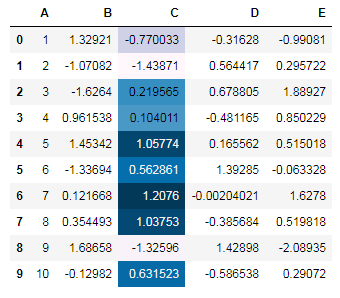Pandas styling Exercises: Write a Pandas program to make a gradient color mapping on a specified column
12. Gradient Color Mapping on a Specified Column
Create a dataframe of ten rows, four columns with random values. Write a Pandas program to make a gradient color mapping on a specified column.
Sample Solution :
Python Code :
import pandas as pd
import numpy as np
np.random.seed(24)
df = pd.DataFrame({'A': np.linspace(1, 10, 10)})
df = pd.concat([df, pd.DataFrame(np.random.randn(10, 4), columns=list('BCDE'))],
axis=1)
print("Original array:")
print(df)
print("\nDataframe - Gradient color:")
df.style.background_gradient(subset=['C'])
Original array:
Original array:
A B C D E
0 1.0 1.329212 -0.770033 -0.316280 -0.990810
1 2.0 -1.070816 -1.438713 0.564417 0.295722
2 3.0 -1.626404 0.219565 0.678805 1.889273
3 4.0 0.961538 0.104011 -0.481165 0.850229
4 5.0 1.453425 1.057737 0.165562 0.515018
5 6.0 -1.336936 0.562861 1.392855 -0.063328
6 7.0 0.121668 1.207603 -0.002040 1.627796
7 8.0 0.354493 1.037528 -0.385684 0.519818
8 9.0 1.686583 -1.325963 1.428984 -2.089354
9 10.0 -0.129820 0.631523 -0.586538 0.290720
Dataframe - Gradient color:
Sample Output:
Download the Jupyter Notebook from here.
For more Practice: Solve these Related Problems:
- Write a Pandas program to apply a gradient color mapping to a specific column in a dataframe using background_gradient().
- Write a Pandas program to highlight one column with a color gradient that transitions based on the cell values.
- Write a Pandas program to generate a gradient color effect on a selected column and compare it with static styling on others.
- Write a Pandas program to set a gradient color scale on a designated column and test different color maps.
Go to:
PREV : Display DataFrame in Heatmap Style.
NEXT : Gradient Color on All Values.
Python Code Editor:
Have another way to solve this solution? Contribute your code (and comments) through Disqus.
What is the difficulty level of this exercise?

